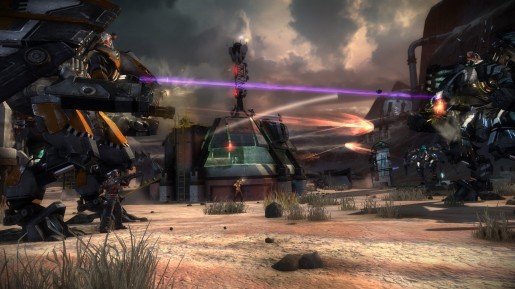
New Spin on Horde Mode
Starhawk’s claim to fame is its Build and Battle system, if you couldn’t tell by now. It acts as the hub of the game’s mechanics, which means it can be found outside of competitive multiplayer matches. The cooperative horde mode receives a boost from the use of this feature. After setting down a rift harvester, the Scabs, those altered by the rift energy, will begin coming out in droves in hopes of destroying the main structure. After 10 waves, victory is yours. During those waves, players can bunker down and hold of the waves of enemies in whichever structure they wish to call down from the heavens. Surviving is only half the game, though, as I stated that the rift harvester needs protection. Deaths result in the redeployment of the player with the aid of a drop pod, but if the harvester is destroyed, it’s game over. This new take on horde mode is engaging and acts as an entertaining diversion from the competitive portion of the online features. It is worth noting that this mode can be played offline via splitscreen. It is a nice touch given that kicking back with friends and playing a game together in the same room isn’t too common in multiplayer-enabled games today.

NOT
Short Single Player
Starhawk offers up single player, something that Warhawk ignored. However, its addition isn’t necessarily a good thing. The story revoles around the space cowboy Emmett, a rift salvager who specializes in wiping out Scabs. The short 5-hour campaign has enough of a story to hold players’ attention, but ultimately it feels like a lengthy tutorial, and that’s basically what the story mode is. Time spent with Emmet allows players to become comfortable with the controls, weaponry, vehicles and, of course, the Build and Battle system. After the five hours are up, you should feel significantly more confident going into an online match. Other than that, you will most likely forget about your wild west space adventure starring Emmet.

Lone Wolves Need Not Apply
Starhawk’s multiplayer thrives on strategy and teamwork. If you happen to be one of those players who enjoys jumping into firefights headfirst by yourself, then you may want to look elsewhere. Everyone has a role to play, but they only work if done correctly. An offensive player taking a Razorback into an enemy base without picking up an allies will surely meet his/her doom. Not only will they die, but they will have taken resources from the team and wasted them without much aid to the goal. This issue is the worst when you find yourself on a team of lone wolves. When everyone scatters, the game gets hectic, but not in a good way. These type of teams are quickly demolished when facing well-structured and cooperative opponents. This is really the only negative aspect of online, but it can drastically change the competitive experience when a team’s soldiers prefer to fight alone.
Verdict
Starhawk is a worthy successor to Warhawk. The multiplayer shines above all else by retaining the core of Warhawk while also breathing new life into its four online modes, mainly through the addition of Build and Battle. Landing your drop pod on an enemy or stomping a Scab with your Hawk mech never gets old. These unforgettable moments are also available in the game’s entertaining take on horde mode. Although the single player is nothing more than a glorified tutorial, it still serves its purpose in a sense since it prepares players for the war online. The environments that span across all of these modes are inspirational pieces and sit amongst the best in eye-candy. The biggest issue isn’t consistent and can only be found in certain members of the community. Overall, this is one PS3 game that competitive multiplayer fanatics should not pass up, just like Warhawk.

